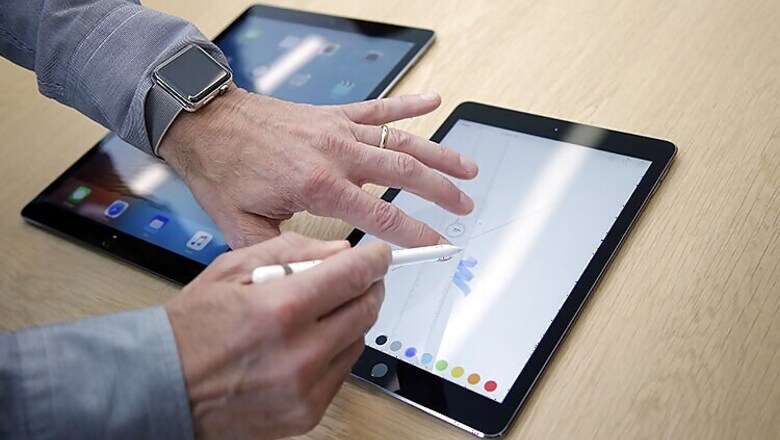
views
New York: Tablets may never again be the consumer sensation they once were, but they are finding new life among professionals.
Apple took aim at that market in announcing a second iPad Pro model this week. Samsung started selling the Windows-based Galaxy TabPro S last week, while Microsoft doubled down on its Surface tablet business last fall with Surface Book, a laptop whose keyboard pops off to leave behind a tablet. Google has its own using Android, the Pixel C.
Unlike early models, these tablets are meant to be used with a physical keyboard and a stylus. That makes them appealing to people looking to get stuff done, whether that's typing a report or drawing on a graphics app.
"It's no secret the tablet business has slowed down overall except in places where there's productivity," says Gary Riding, a senior vice president for mobile computing marketing at Samsung. ("Productivity," in this case, being jargon for work as opposed to play.)
These new devices also have higher price tags. Many sell for almost $1,000, or even more with accessories. Companies market them as PC replacements rather than devices for watching video, reading books and playing games — that is, things you can already do with your phone.
The Surface Pro 3 is "much thinner than a laptop, and when you have the case with the keyboard, it's essentially a laptop," says Ryan Hastman, who now leaves his Mac laptop behind while traveling to raise money for the University of Alberta in Canada.
Tablet shipments fell 10 per cent to 207 million worldwide last year and are projected to fall another 6 per cent this year, according to IDC. But one subset — tablets with detachable keyboards — more than doubled to 17 million last year. It's projected to grow to 64 million in 2020 and represent 30 per cent of the overall tablet market, rather than 8 per cent now.
"It's not all doom and gloom," IDC analyst Jitesh Ubrani says. "Microsoft's done a very good job at marketing detachables. Everyone's now jumping on that bandwagon."
In a sense, Apple was a victim of its own success following the iPad's debut in 2010. Tablets took off with consumers who found them appealing replacements for home laptops. But people haven't replaced them as often as phones. And as phones got bigger, some people began wondering whether they needed a tablet at all.
Enter Microsoft, long the king of "productivity" software, which in 2012 designed a tablet that ran Windows and targeted professionals. The Microsoft Surface didn't have the fun apps that iPads and Android tablets had, but it had Word, Excel and other Office apps long before entertainment-oriented devices did. It also has a USB port and other features missing in most tablets.
It took Microsoft two years to get it right, though. The Pro 3 in 2014 was the first Surface with a fully adjustable kickstand that mimicked the flexibility of laptop screens. And last fall's models were the first Surface devices with Windows 10, which mirrored traditional PCs much more than the Windows 8 it replaced.
"Everyone wants a tablet, and everyone needs a laptop," says Brian Hall, Microsoft's general manager for Surface. "You can have an approach that says people need to buy one of each, or you can have an approach that says there's a happy medium."
The holiday quarter was the best yet for Surface, with revenue increasing 29 percent to $1.35 billion.
But don't count Apple out. IDC estimates that Apple sold more than 2 million iPad Pros in the holiday quarter when it launched, compared with 1.6 million units for Surface. Apple's advantage: apps designed from the start for touch screens and battery conservation, rather than ones adapted from the mouse-and-keyboard world of plugged-in Windows PCs.
Now, Apple is giving customers additional choice — a 9.7-inch iPad Pro that starts at $599, $200 cheaper than the 12.9-inch original (add about $250 for the keyboard and stylus). Just as Microsoft and Samsung have done, Apple is targeting the hundreds of millions of people whose Windows machines are at least five years old. Apple says most iPad Pro customers are coming from Windows.
Bryan O'Neil Hughes, head of outreach and collaboration for software maker Adobe, says a faster processor and better graphics make the Pro something people choose — rather than settle for — when replacing PCs. Many professionals in creative industries, he says, prefer tablets over laptops for presentations, sketching and design.
Nicole Dalesio, an artist and teacher in San Jose, California, says the iPad Pro's stylus offers more precision than other devices and "mimics the natural effect of using things like brushes or pencils or charcoal."
That's not to say PCs are going away. Hall acknowledges that people have cheaper options with traditional laptops. And while Dallas chef Nicholas Harrison says his iPad Pro can do everything his restaurants need, he has a PC at home for hard-core games.
That's not to say entertainment-focused tablets are going away, either. Amazon has a healthy business selling such devices for as low as $50 — creating its own niche, just as Apple, Samsung and Microsoft are with professionals.
"This is what happens as markets mature," says Jan Dawson, chief analyst with Jackdaw Research. "There's a lot more market that can only be served with niche and segmented products."

















Comments
0 comment